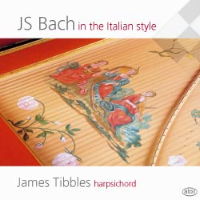
Robust and Spirited
James Tibbles
plays J S Bach -
heard by
HOWARD SMITH'... worthy of widespread international recognition.'
|

|
James Tibbles is Senior Lecturer in Organ and Early Keyboards (Auckland University) and Early Music Studies co-ordinator. In addition he's a member of the early music group 'Extempore', an Auckland-based period instrument ensemble formed in Holland (1985) while James and Sally Tibbles and Graham McPhail were undertaking post-graduate study at the Royal Conservatory (The Hague).
Among his research topics have been: (a) Performance on harpsichord, organ and fortepiano; (b) The history of early music in New Zealand; (c) J G Harrer, Thomascantor, Leipzig 1750-1755; (d) Performance of baroque music for orchestra and/or choir; Leipzig and the 'Dresden style'.
Current James Tibbles researches include: a history of the development of historically informed performance in New Zealand, based on study of collections of historic instruments, research into instrument building and biographies of major figures in New Zealand's early music movement. Performances of solo, chamber and orchestral repertoire from the eighteenth century.
Listen -- Presto (Concerto in the Italian Style)
(track 13, 0:00-0:57) © 2009 Atoll
His Atoll CD recital is likely to have added appeal as it includes highlights of the repertoire, among them The 'Italian Concerto' BWV 971 (1735) and the aria Bach used as the theme for his seminal Goldberg Variations BWV 988' (1741).
Setting aside Sir Thomas Beecham's oft-quoted harpsichord put-down, Vaughan Williams likened the instrument (when played in a large room) to 'the ticking of a sewing machine. To my mind it never has a pleasant sound', he added. Percy Scholes, compiler of the first edition of The Oxford Companion to Music, described it as akin to 'performing on a bird cage with a toasting fork'.
Not so here. Tibbles puts paid to all these detractors. His recital is robust and spirited with a pleasing rounded ambience at its edges. And while occasional moments are rhythmically 'four square' (viz the Andante BWV971) one can hardly quibble at Tibbles' interpretative recognition of the underlying spirit and letter inherent within Bach's keyboard music.
Turn to the early Glenn Gould (piano) recording of the Italian Concerto and the Andante (see above), though rhythmically so precise, springs into life. The 1959 LP recording, made when Gould was twenty seven, was reissued on CD (1999) and in 2002 enhanced as an SACD (Sony Classical SNYC 87753).
A true highlight is 'Capriccio on the Departure of his most Beloved Brother (sopra la lotananza del suo fratello dilettissimo) in B flat major, BWV 992', first published in Leipzig in 1839.
In a 77-minute CD (BIS 1037) of praeludia, fantasias and fugues plus the Capriccio in honour of Johann Christoph Bach BWV 993, and Capriccio on the Departure of his Most Beloved Brother BWV 992, Masaaki Suzuki (born in Kobe, Japan in 1954) shows a rare affinity with this repertoire.
His parents were both Christian and amateur musicians, and Masaaki learned composition and organ at the Tokyo National University of Fine Arts and Music. Later he studied harpsichord and organ with Ton Koopman and Piet Kee and improvisation with Klaas Bolt at the Sweelinck Conservatory, Amsterdam. He became founder and musical director of the Bach Collegium Japan.
Suzuki is Visiting Professor of Choral Conducting and conductor of Yale Schola Cantorum; a joint appointment between Yale Institute of Sacred Music and the Yale School of Music.
The Suzuki recordings with performances of outstanding perception and clarity have rarely been superseded.
Nonetheless no serious student or Bach aficionado should be without recordings of Ralph Kirkpatrick (1911-1984). His extensive keyboard palette and natural rhythmic niceties are superbly managed while cloudy and over-reverberant segments may easily be overlooked.
In 1956, DGG (Germany) chose Ralph Kirkpatrick to record all of the keyboard works of Bach (excluding the organ works) for its Archiv label. He recorded most of the works on the harpsichord and the entire Well-Tempered Clavier on both the harpsichord and the clavichord. The project was completed in the late 1960s. (See: Ralph Kirkpatrick: A Bibliography and Discography by Meredith Kirkpatrick, Boston University).
Veteran Canadian Kenneth Gilbert's appealing performances (Archiv Produktion, 1986/1991) are equally worth careful consideration.
Tibbles takes the components of the Fantasia and Fugue in A minor, BWV904 as distinct entities: his Fantasia (track 10) precedes the Italian Concerto (BWV 971), then the Fugue (track 14) follows.
His final solo item is the Aria from Goldberg Variations -- a funereal tortoise beside Glenn Gould (1981) and Tatiana Nikolayeva's (1992) unusually dawdling hares.
Listen -- Aria (BWV 988 I)
(track 15, 0:00-1:11) © 2009 Atoll
The concluding item, Concerto in C major, BWV 1061, began as a concerto for two harpsichords unaccompanied (in similar manner to the Italian Concerto). Its accompanying strings do not act in an independent capacity, and only appear to augment cadences; they remain silent in the Adagio ovvero Largo leaving the soloists with a busy antiphonal role. The complete scoring is for harpsichord 1/2 solo, violin 1/2, viola, continuo (cello, violone).
With Tibbles' and Jenny Thomas' dual artistry the concerto is bracing and utterly rewarding; its Adagio ovvero Largo especially beautiful -- lulling and contemplative.
Listen -- Adagio ovvero Largo (Concerto in C for two harpsichords)
(track 17, 3:37-4:55) © 2009 Atoll
Atoll's Tibbles programme is characterized by an academic acuity and technical flair worthy of widespread international recognition. Bach keyboard students take note.
Copyright © 30 December 2009
Howard Smith,
Masterton, New Zealand
 CD INFORMATION: J S BACH IN THE ITALIAN STYLE
CD INFORMATION: J S BACH IN THE ITALIAN STYLE
| 
